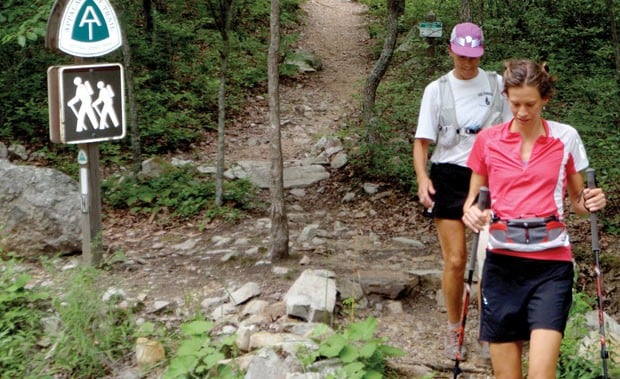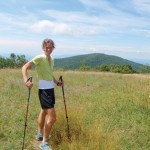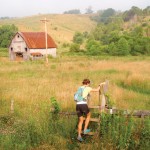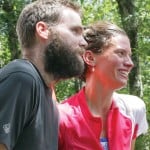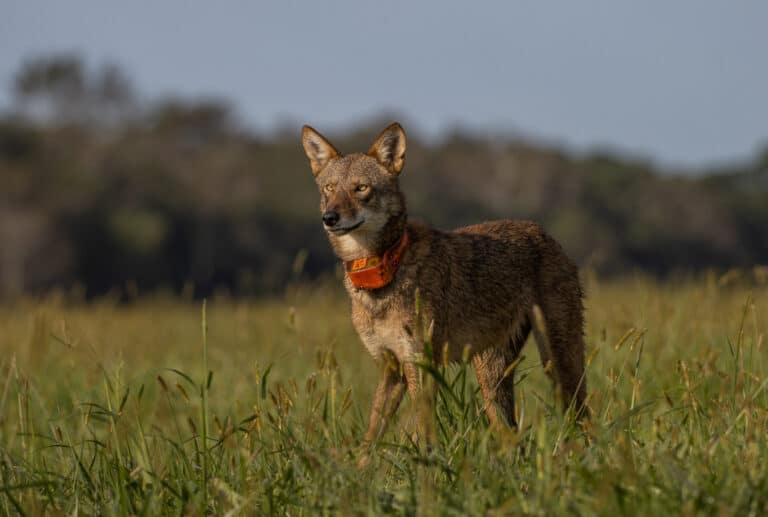When I graduated college, I wanted an adventure. I had spent my entire life doing what was expected of me and trying to please other people. Now I needed time to define my own expectations.
I decided that the 2,181-mile Appalachian Trail would be a perfect post-college activity, and hoped it would give me enough time to figure out what it was I wanted to do with my life.
The experience was far more difficult than I had ever imagined it would be. Beyond the physical hardships of hiking each day, I had to endure several unique challenges that most thru-hikers never encounter: I was struck by lightning, my eye froze shut in a snowstorm, I was followed by a hiker that I wanted nothing to do with, I suffered the early stages of trench foot, and I was deeply affected mid-hike when I encountered a death on the trail. When I finally reached Mount Katahdin in Maine and touched the worn brown sign that marked the end of the trail, I swore to myself that I would never, ever thru-hike again.
After my first thru-hike, I immediately delved into the “real world” and got a “real job.” I really enjoyed my marketing and events position at the museum and I was working with great people, so it caught me off-guard when several weeks, then months, passed and all I could think about was the trail.
I was a different person than I had been before the trail. I liked the woman who finished much better than the naïve 21-year-old who started the path. My values had changed, and I now appreciated simplicity, solitude, and silence. I missed the quality relationships that I enjoyed on the trail. It seemed that in the woods, I got to know people for who they were as opposed to what they did. I longed to be back in rhythm with nature: waking up at dawn to the serenade of songbirds and going to bed at dusk to an insect lullaby. Plus, as great as my job was, it still was a desk job, and I missed moving.
It didn’t take long for me to decide that as soon as I could save up enough money and time off of work, I would return to the woods.
Hiking Partner
Marriage was not necessarily part of my long-distance hiking plans, but when I met Brew, I also realized it was unavoidable. It sounds cliché, but he was literally the best man I had ever met. However, my desire to go into the woods has not always been easy for him. With time, Brew became more comfortable with my ventures but he never enjoyed being left at home.
Three weeks before I left for a long-distance hike in Australia, Gary Michael Hilton abducted Meredith Emerson on Blood Mountain, Ga. Meredith and I were the same age, and it seemed as if we could have been the same person. Her courageous actions led authorities to capture the man who was responsible for the murder of Cheryl Hines in Florida, and who is accused of killing John and Irene Bryant in the nearby Pink Beds of North Carolina. Yet, despite Meredith’s bravery, her life was not spared, and it was a terrifying reminder that bad things can happen in the woods. For the first time in years, I wondered whether or not I should hike on my own.
Meredith was a hero; she stopped a serial killer and saved lives—potentially my own. I wanted to honor her memory by living fully— and by hiking. I had already planned on hiking the Appalachian Trail again that summer, but now I wasn’t just hiking for me, I was hiking for Meredith, too.
When Brew and I decided to chase the women’s record on the Appalachian Trail in 2008, the idea was born out of passion and practicality. I loved the trail, but I loved Brew more. Neither one of us wanted to be separated from the other for several months. Until this time I had always hiked on my own with a full backpack, but Brew was a teacher, and he agreed to donate his summer to help me hike the trail and honor Meredith.
Our goal was to establish a women’s record on the trail. Until this time, only men had recruited support teams in an attempt to travel down the path as quickly as possible. I wanted to demonstrate that women could set trail records, and I had a feeling that Meredith would approve.
I hiked 11 to 13 hours every day, never taking a day off, with only brief stops to rest. At times, where the grade was gentle and the tread less technical, I even ran—or rather, shuffled—a little bit.
Physically, I was working harder than I had in my entire life, yet in a way, the experience wasn’t as difficult as I had imagined. I could meet Brew at road crossings several times throughout the day. I only had to carry a daypack. I had milkshakes and French fries brought to me on the trail, and I could change into a fresh pair of socks every morning. I loved trail records!
After completing the trail in 57 days, I felt tired and happy. But I walked down Springer Mountain knowing that I had not used all my energy reserves. In retrospect, I realized that I had put limitations on myself throughout the journey. For the most part, I was only willing to hike during daylight hours and I stopped at dusk, even when my body felt that it could keep going. And, I was even more disappointed when I realized that I had set limitations on myself based on the fact that I was a woman. I bought into the idea that men are faster and stronger than women and that a woman should consider herself fortunate to be within 10 days of the men’s record.
At that time, I didn’t have any immediate plans to return to the Appalachian Trail, but as the seasons changed, I became convinced that a trail record really has little to do with strength and speed. Instead, the most important qualities of a record setter are efficiency, consistency, and knowledge of both the trail and oneself. Before a full year passed, I found myself wanting to try for an Appalachian Trail Record once again.
The Overall Record
A close friend once told me, “If you don’t fail at something at least once, then you haven’t set your goals high enough.” I realized that failure was a huge possibility in returning to the A.T. for the overall record. And I didn’t care.
I hated the idea of not trying far more than the thought of not succeeding. I had finished my last A.T. hike with gas left in the tank, and no matter where my hike ended in 2011, I promised myself that I would leave the trail empty, unable to take another step. I wanted to know what it felt like to give 100 percent.
One day on a record attempt feels like an eternity. I told myself that the first two weeks of the trip would be the most painful fourteen days of my life. I was right.
The first four days of the trip were extremely difficult. My body was trying to cope with all the dull aches and sharp pains that come at the beginning. The bottom of my feet stung with each step, but I expected this. I knew that if I could work through it, I would then develop the desired numbness below my ankles that would last for the rest of the hike.
Despite the initial pain, I loved being back on the A.T. The path felt familiar, and each day I looked forward to the upcoming terrain. On the morning of the fourth day, I was able to do something that I had always wanted to do. I forded the Kennebec. The wide river has a canoe ferry to help hikers across the fast-moving torrents – and for good reason. But with the help of my good friend and 16-time A.T. veteran, Warren Doyle, I crossed the river on foot. The water was chest high and even though the endeavor demanded a high level of exertion, I experienced a burst of energy upon reaching the opposite shore. I was experiencing the trail in a new way and I loved it—until day five.
That’s when I developed shin splints. I had never experienced shin splints before, and the pain was so intense that I was convinced I had stress fractures in both legs. Every step hurt. At times my legs would buckle beneath me, unable to support my weight. My hiking poles became crutches, and there were several times when I hiked down the trail sobbing and yelping because of the unbearable sensation in my lower legs. I knew that former record holders had worked through shin splints, and I decided that I would try to do the same, at least until I was forced to crawl.
My shin splints stayed with me throughout the White Mountains, where I had two straight days of sleet and rain. I fell countless times on the slick rocks, and at one point I looked at my leg and discovered there was more blue and purple than tan. When I finally reached Vermont hoping that softer terrain would heal my legs, I contracted a violent illness that forced me off-trail and into the bushes every half-mile. My body had not adapted to the challenge. I thought I was done.
I told Brew at the base of Mount Killington that I wanted to quit. Then Brew, my sympathetic, caring, reasonable husband who believed in a life lived with balance and hikes that included naps and meditation, told me that I had to keep going.
I couldn’t believe my ears. I had expected Brew to coddle and comfort me, not to tell me to keep hiking. It was so contrary to his personality and demeanor that it made me realize how much he believed in me. Brew knew how much this opportunity meant to me, and even though we were 1,700 miles away from Springer Mountain, and I was suffering from shin-splints and diarrhea, he still believed that we could set the record.
I left the road and slowly, painfully made my way toward the top of Mount Killington. Once I reached the other side of the mountain, there was no looking back. Brew’s belief had rekindled my desire to set the record. The trail had taken away any sense of pride or false notion that I could do this on my own. I knew that I could not be successful without Brew, and we would only achieve our goal with the help of others.
South of Vermont, the terrain and weather became more agreeable and my shin splints finally started to subside. It took over 1,000 miles for the pain to fully go away.
Going the Distance
Our daily routine consisted of waking up at 4:45 a.m. I would try to start hiking at 5 a.m. and then I would continue hiking for the next 16 to 17 hours. My intermittent breaks came at the road crossings where I met Brew. However, it was not a time to relax. Instead, it was my job to ingest as many calories as possible, bandage any problem blisters, ice my shins, and then get back on the trail as soon as possible. I would continue hiking until 9 or 10 o’clock at night, when I came to a good camping site or road crossing. There I would quickly try to eat dinner, wipe down my limbs with Wet Ones, and then crawl into my sleeping bag for 6 hours of sleep.
From the very beginning the numbers were overwhelming. Talk of miles per hour and daily averages psyched me out. We occasionally talked about where former record holder Andrew Thompson would be relative to our location, but that didn’t motivate me either. Andrew is a great person and amazing athlete, worthy of a trail record. Even when I tried to vilify him in my mind, it still didn’t inspire me. The trail record wasn’t about numbers or about beating Andrew Thompson; it was about doing my best. That became our mantra.
Whenever I left the car at a road crossing, Brew would yell after me, “Just do your best.”
Brew and I worked together as one unit, and I have never in my life trusted someone so completely. We also benefited from the invaluable support of numerous friends who assisted us along the trail: some provided food, others helped with logistics, and some, my personal favorites, hiked with me and carried my pack. It’s called muling, and I love it.
The closer we got to North Carolina, the more support we received. Because I wasn’t running at all, a wide variety of people were able to hike with me on the trail. I hiked with both of my brothers, two retirees, several previous thru-hikers, and a handful of trail runners. I even had the opportunity to hike with two of my trail heroes, Anne Lundblad and Matt Kirk. The fact that individuals who I believed to be superhuman were coming to the trail to hike with me was both humbling and encouraging.
Toward the end of the hike it felt as if I were straining for a goal that was much larger and more involved than I had ever imagined. I wasn’t just hiking for myself anymore. I was hiking for a community that believed in defying the odds, striving for your fullest potential, and helping one another. I was hiking to promote a path that has the power to positively change and impact lives. I was still hiking for Meredith. And I was hiking because it had become a symbol of my husband’s sacrificial love for me.
Reaching the top of Springer Mountain, hand in hand with Brew, was one of the most amazing moments in my entire life.
I had set the overall A.T. speed record in 46 days, 11 hours, 20 minutes. Even at the finish, the record still was not about the numbers. It was about the memories and friendships we built along the way. We had given everything we had to the trail, and it had given us even more in return.
Walking back down the mountain, I stumbled down the dirt tread, tripping on roots, stubbing my toes on rocks, and struggling to put one foot in front of the other. I was so tired that the path blurred in front of me.
I smiled and thought to myself: “So this is what 100 percent feels like.”
